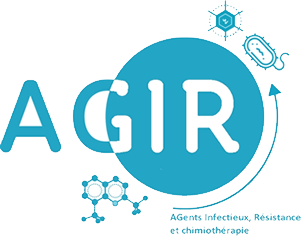Plasmodium falciparum
You are here : Accueil > Research program > Plasmodium falciparum
The emergence of resistance to antimalarial drugs and the adverse effects that some cause are the two main causes of failure of anti-infective chemotherapy. Our team is working on the synthesis and evaluation of new molecules having a specific action on Plasmodium falciparum, the parasite responsible for malaria, and capable of countering the phenomena of resistance at the origin of a decrease in the intracellular concentration of the therapeutic agent. These molecules come in particular from the development of new amino-alcohol derivatives of quinoline structure.
The culture of Plasmodium falciparum and the tests concerning the inhibition of the heme detoxification pathways carried out in the laboratory (inhibition of the formation of β-hematin or inhibition of the degradation of hemin by hydrogen peroxide and glutathione ), make it possible to evaluate and study the mechanism of action of the synthesized molecules. Recent studies have shown that the (+) enantiomer of mefloquine would be the most active against malaria while the (-) enantiomer would be responsible for the central side effects. In this context, our team has expertise in the enantioselective synthesis of new molecules, analogues of mefloquine, with a 4-aminoquinolinol motif. The first studies, patented in 2011 and 2012, show that 4-aminoquinolinols of the S configuration are significantly more active than those of the R configuration. These molecules act in particular by blocking the detoxification of heme in the parasite. For compounds substituted by a linear chain, the main mechanism would be the inhibition of the formation of β-hematin, the synthetic equivalent of hemozoin crystals produced by the parasite in order to limit the accumulation of free hematin (oxidized heme), which is toxic to him.
In order to better understand the mechanism of crystal formation and the interaction between antimalarial molecules and hematin, we also use molecular modeling tools. A model of the ferriprotoporphyrin IX dimer and β-hematin microcrystals using an AMBER-like force field was built with the q4md-forcefieldtools. This model is used in the study of the interaction of molecules with a quinolinol motif by docking and molecular dynamics in addition to quantum chemistry calculations.
The culture of Plasmodium falciparum and the tests concerning the inhibition of the heme detoxification pathways carried out in the laboratory (inhibition of the formation of β-hematin or inhibition of the degradation of hemin by hydrogen peroxide and glutathione ), make it possible to evaluate and study the mechanism of action of the synthesized molecules. Recent studies have shown that the (+) enantiomer of mefloquine would be the most active against malaria while the (-) enantiomer would be responsible for the central side effects. In this context, our team has expertise in the enantioselective synthesis of new molecules, analogues of mefloquine, with a 4-aminoquinolinol motif. The first studies, patented in 2011 and 2012, show that 4-aminoquinolinols of the S configuration are significantly more active than those of the R configuration. These molecules act in particular by blocking the detoxification of heme in the parasite. For compounds substituted by a linear chain, the main mechanism would be the inhibition of the formation of β-hematin, the synthetic equivalent of hemozoin crystals produced by the parasite in order to limit the accumulation of free hematin (oxidized heme), which is toxic to him.
In order to better understand the mechanism of crystal formation and the interaction between antimalarial molecules and hematin, we also use molecular modeling tools. A model of the ferriprotoporphyrin IX dimer and β-hematin microcrystals using an AMBER-like force field was built with the q4md-forcefieldtools. This model is used in the study of the interaction of molecules with a quinolinol motif by docking and molecular dynamics in addition to quantum chemistry calculations.





